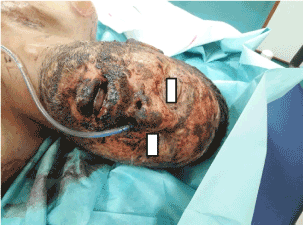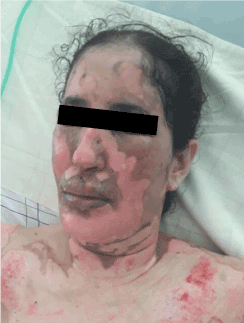The burn is a physical and psychic trauma causing a modification of the body envelope and a break with the previous life by its complications and its consequences. Care must be comprehensive from first aid to reintegration through early rehabilitation and occupational therapy support centered on the person, his functional abilities, his productivity, and the activity analysis. The aim is to avoid putting the patient out of the way and to help him regain his place at the social, family, and professional level.
facial burn, rehabilitation, social reintegration
The burn is a destruction of the skin and / or underlying tissue produced by the action of heat, electricity, radiation or chemicals. It is a common condition. In France, around 12,000 burn patients are hospitalized each year with an average age of 30, a sex ratio of 1.7 and burns, mainly facial and cervical (21.9% of burns) [1]; and 50% of burns have facial damage because it is an open area. The origin is mainly thermal by flame or burning liquid. Burns involve: the vital prognosis by involvement of the upper airways, the functional prognosis by ocular or auditory impairment, and the aesthetic prognosis by modification of the appearance of the face. The severity of the injury depends on several factors: the extent of the lesion, its depth, its location, the age of the victim, the underlying pathologies and the presence of other associated trauma.
Facial burn
Histology of the face: the skin is made up of three layers:
The epidermis: is neither vascularized nor innervated, contains keratin (mechanical protector) and melanin (protector against ultraviolet rays) and is based on the dermo-epidermal junction which is rich in basal cells and responsible for renewal each 30 days.
The dermis: is vascular and innervated, rich in fibroblasts and responsible for protein synthesis: collagen (structure), reticulin (resistance) and elastin (elasticity).
The hypodermis: formed of adipose-fatty tissue and has the role of water regulation and sliding of the skin on the underlying tissues.
Peculiarities of the face: It is characterized by a flexibility of the facial coat, an irregularity in thickness and variability in coloring from one site to another. The face is the seat of the sensory organs (nose, ears, and eyes) and the aerodigestive orifices essential for food and communication.
Role of the face on the psychological side:
The psychological role of the skin has been the field of research of many psychoanalysts for very long time [2]. The word face is related to the notion of appearance and the skin is perceived as a psychic envelope, the damage of which leads to disorganization with serious physical and psychological consequences. "In addition, thanks to its mobility and its power of expression, the face is the geographical location of the personality, the intimate, the identity, the human" [3]. The face with all its facial expressions is a mirror of the person's personality and thoughts.
Histologically
It occurs following the destruction of the skin covering a set of changes to the type of impairment of sensitivity (hypo or facial anesthesia), an enlargement (severe if localized in the cervico-thoracic level, lower face or areas that are not very mobile), and multidirectional (closets) or unidirectional (static or dynamic flanges) retractions, which are more serious if located at the peri-orifice level. If the burn is deep, it causes a charring of the tissues, or even an aesthetic amputation (nose, ear, etc.) with dyschromia following disharmonious scarring of the skin. The vital prognosis can be jeopardized by respiratory complications if the burn involves the airways, and if the lesion is palpebral, it is the functional prognosis that is at risk (Figure 1).

Figure 1. Severe facial burn from damage to natural orifices.
- The lesions that can be encountered are:
- In the eyelids: entropion, ectropion, lagophthalmos, ptosis, corneal ulceration.
- In the nose: nasal stenosis, mutilation by cartilage destruction.
- In the ears: chondrite or cartilage melt.
- At the level of the lips: labial ectropion, microstomy, oral incontinence, folliculitis, disorganization of the reliefs, facial asymmetry, cicatricial hyperthrophy and disruption of facial expression (Figure 2).

Figure 2. Facial burn: disruption of facial expression.
On the psychological level
After a facial burn, the patient is unable to cope with his new image. He finds it very difficult to imagine the aspect of the most social part of his body which is the area most exposed to the eyes of others [4].
Indeed, the deterioration of the aesthetics of the person is considered to be a monstrosity of the body, it is the most difficult experience to overcome.
Functionally
Skin destruction undoubtedly has repercussions on the quality and gestures of daily life. Facial burn with its physical and psychological consequences has a significant socio-professional and psycho-social impact, hence the interest in comprehensive care with a serious determination on the social, family, and professional reintegration of the burned patient.
Burned course
Burn victims require comprehensive multidisciplinary care from the accident and primary care to their reintegration into society. In the literature, studies have focused on the four structures of the care pathway [1]:
- Burn treatment center: where initial care is provided with primary assessment of the general condition and determination of the surgical strategy.
- Follow-up care and rehabilitation center specializing in the treatment of burn patients: once the scar is closed, where the patient receives comprehensive rehabilitation care.
- Stay in spa treatment following the patient's discharge from the rehabilitation center, thus breaking with the hospital environment, and opening up the opportunity to make contact with other burn victims of different stages of development.
- Restorative surgery after scarring or if serious functional complication allowing to optimize the functional capacities or improve the physical appearance of the patient.
This medical and surgical course is organized by regular consultation appointments every two to six months to ensure good follow-up and support for the patient during the various stages of development. It is possible to continue treatment in a private practice, but it will depend on the own resources of the burned patient.
Rehabilitation of facial burn
In parallel with the treatment started in intensive care, rehabilitation is instituted with a view to minimizing the deformations due to the burn. Rehabilitation of burns goes through three main stages:
- In surgical resuscitation
- In a specialized rehabilitation center
- And at home.
Assessment
It must be carried out at the beginning before the installation of the edema otherwise it is necessary to wait for its absorption under medical treatment. The cutaneous-trophic, osteo-articular and functional assessments serve as a reference and basis for emphasizing the objectives and the means of rehabilitation.
Motor physiotherapy
The principle of manual therapy is to fight against fibrosis, adhesion and the volume of scars. The massages must be practiced every day, avoiding pulling on the skin and underlying tissues, of centripetal, millimeter-like kneading-friction sense by forming a skin fold through the pulp of the fingers and simultaneously approaching it. Massage creams can be used to facilitate the sliding of the fingers. Joint mobility is maintained during physiotherapy sessions by the principle of maximum skin capacity.
Occupational therapy
Occupational therapy is a technique of great contribution with the realization of the apparatus with type of thermoplastic neck brace for the cervico-facial retraction, posture orthoses to decrease the retractions, compressive masks and silicone gels, nasal conformers or mouth to reduce microstomy.
The active oral orthosis is an active tool for maxillofacial rehabilitation. Orthotics must be comfortable, biocompatible, of reasonable sizes suitable for the reduced opening of the mouth. Their goal is either to maintain or enlarge the mouth opening.
The principle of making temporary compressive and rigid compressive clothing intended for the face and the neck is to create hypoxia which will be responsible for the decrease in collagen production and therefore reduction of hypertrophy.
These garments must be worn 23 hours a day at a pressure of 30 mmHg. One can resort to the realization of early partial tarsorraphies for deep burns; they put the eyelids in maximum skin capacity. Occupational therapy is also interested in the work of the elasticity of the skin and the reshaping of the mouth-cheek area. Advice on hygiene and cosmetics is presented to the patient to facilitate the work of acceptance of self-image by corrective makeup for scars and its reliefs and redness of inflammatory origin. Psychological care is necessary, not to be overlooked. The psychologist accompanies the burned facial throughout the rehabilitation to facilitate the acceptance of self-image and the confrontation of the gaze of others.
Social inclusion
The person is defined by their activity and their role in society, and when a burn occurs, they become limited on a social, family, and professional level. We must first assess the social situation of the person in qualitative and quantitative terms before implementing a socio-professional reintegration procedure which is defined by the International Index and Dictionary of Rehabilitation and Social Integration (IIDRIS) as “an action aiming to develop an isolated or marginal individual towards a situation characterized by satisfactory exchanges with his environment; it is also the result of this action, which is assessed by the nature and density of the exchanges between an individual and his environment"[5].
Indeed, the burn is an incident which disturbs the life of the victim, it marks a break with the previous life and signs a withdrawal from society. The patient is therefore unable to perform his social and family roles.
Occupational therapy participates intensively in this human project by proposing variable activities to obtain a suitable occupational balance adapted to the person. So, it is through and through production and professional activity that associations manage to integrate people with facial burns.
In the international literature, a strong correlation has been objectified and demonstrated between professional instability and health [6].
Also, the return to productivity and the professional occupation following a burn is an indicator of the success of rehabilitation care and good psycho-social adjustment [7].
Facial burn is common as a location. Management must be multidisciplinary and early in the face of serious complications that may jeopardize the vital, functional, and aesthetic prognosis. The follow-up must be regular and involve the physical and mental side of the victim. Social, family, and professional integration occupies a significant place in the overall management of facial burns in order to limit the dismissal of a person who has ended his previous life.
- Anzieu D (1995) The Skin-Self. Paris, Dunod, France.
- Malet R, Consoli SG (2005) Psychological and socio-cultural aspects of the skin and appearance. EMC Cosmetology and Aesthetic Dermatology.
- Bargue L, Vaylet F, Le Bever H, L’Her P, Carsin H (2005) Respiratory lesions and burns. Respiratory Disease Review 22: 449-460.
- Dubuis A (2014) Burns of the face: Tests and struggles for recognition, Lausanne, Antipodes, Switzerland.
- National Council for Policies to Combat Poverty and Social Exclusion (2014) Social integration, social integration. Available from: https://www.cnle.gouv.fr/Insertion-sociale-integration.html
- Moulin JJ, Labbe E, Sass C, Gerbaud L (2009) Health and professional instability: Results from the health insurance health examination centers. J Epidemiol Public Health 57: 141-149.
- Attoe C, Pounds-Cornish E (2015) Psychosocial adjustment following burns: An integrative literature review. Burns 41: 1375-1384. [Crossref]


